2016 MERCEDES-BENZ S-COUPE tire size
[x] Cancel search: tire sizePage 21 of 410
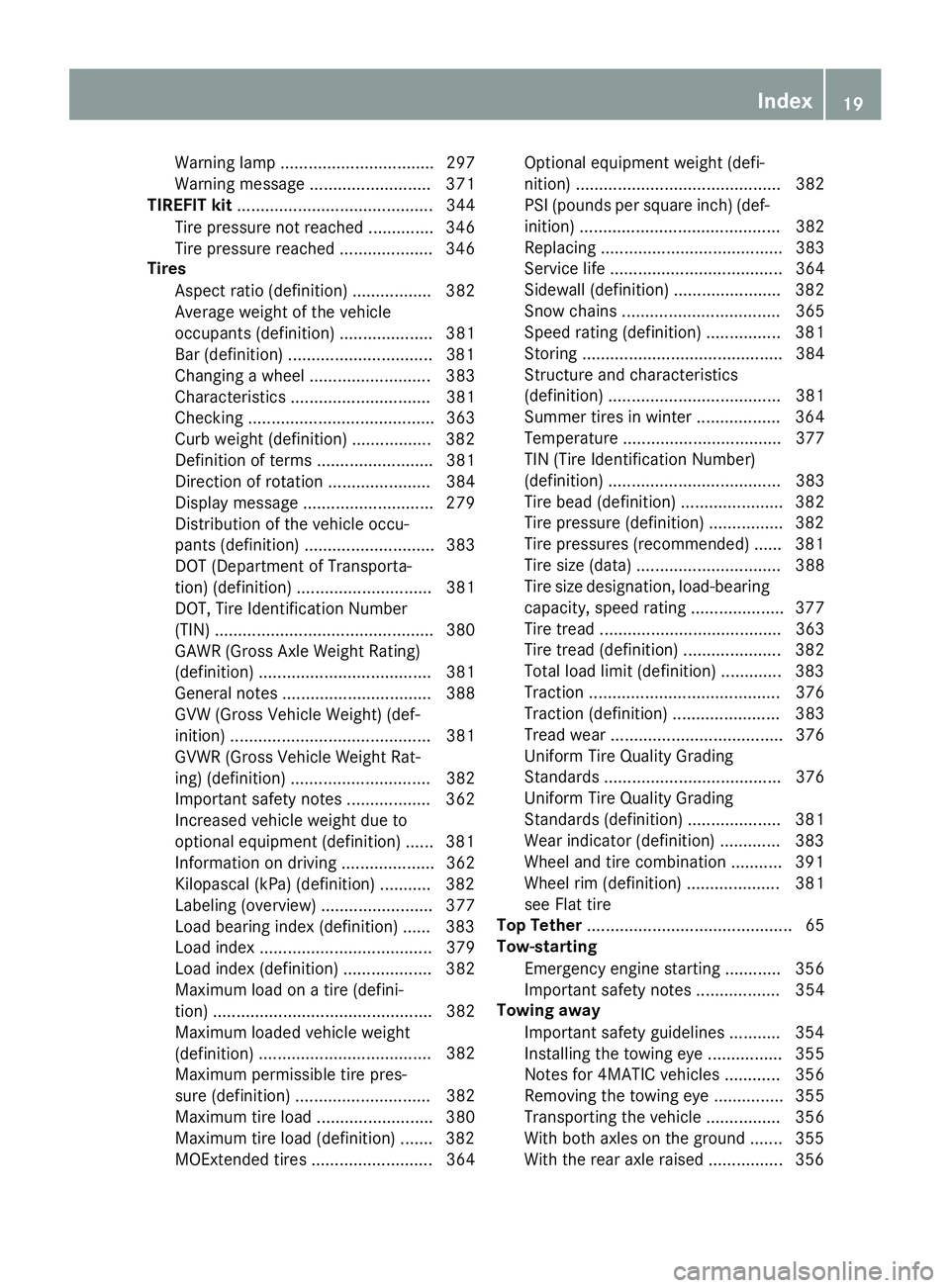
Warning lamp ................................. 297
Warning message .......................... 371
TIREFIT kit .......................................... 344
Tire pressure not reached .............. 346
Tire pressure reached .................... 346
Tires
Aspect ratio (definition) ................. 382
Average weight of the vehicle
occupants (definition) .................... 381
Bar (definition) ...............................3 81
Changing a wheel .......................... 383
Characteristics .............................. 381
Checking ........................................ 363
Curb weight (definition) ................. 382
Definition of terms ......................... 381
Direction of rotation ...................... 384
Display message ............................ 279
Distribution of the vehicle occu-
pants (definition) ............................ 383
DOT (Department of Transporta-
tion) (definition) ............................. 381
DOT, Tire Identification Number
(TIN) ............................................... 380
GAWR (Gross Axle Weight Rating)
(definition) ..................................... 381
General notes ................................ 388
GVW (Gross Vehicle Weight) (def-
inition) ........................................... 381
GVWR (Gross Vehicle Weight Rat-
ing) (definition) .............................. 382
Important safety notes .................. 362
Increased vehicle weight due to
optional equipment (definition) ...... 381
Information on driving .................... 362
Kilopascal (kPa) (definition) ........... 382
Labeling (overview) ........................ 377
Load bearing index (definition) ...... 383
Load index ..................................... 379
Load index (definition) ................... 382
Maximum load on a tire (defini-
tion) ............................................... 382
Maximum loaded vehicle weight
(definition) ..................................... 382
Ma
ximum permissible tire pres-
sure (definition) ............................. 382
Maximum tire load ......................... 380
Maximum tire load (definition) ....... 382
MOExtended tires .......................... 364 Optional equipment weight (defi-
nition) ............................................ 382
PSI (pounds per square inch) (def-
inition) ........................................... 382
Replacing ....................................... 383
Service life ..................................... 364
Sidewall (definition) ....................... 382
Snow chains .................................. 365
Speed rating (definition) ................ 381
Storing ........................................... 384
Structure and characteristics
(definition) ..................................... 381
Summer tires in winter .................. 364
Temperature .................................. 377
TIN (Tire Identification Number)
(definition) ..................................... 383
Tire bead (definition) ...................... 382
Tire pressure (definition) ................ 382
Tire pressures (recommended) ...... 381
Tire size (data) ............................... 388
Tire size designation, load-bearing
capacity, speed rating .................... 377
Tire tread ....................................... 363
Tire tread (definition) ..................... 382
Total load limit (definition) ............. 383
Traction ......................................... 376
Traction (definition) ....................... 383
Tread wear ..................................... 376
Uniform Tire Quality Grading
Standards ...................................... 376
Uniform Tire Quality Grading
Standards (definition) .................... 381
Wear indicator (definition) ............. 383
Wheel and tire combination ........... 391
Wheel rim (definition) .................... 381
see Flat tire
Top Tether ............................................ 65
Tow-starting
Emergency engine starting ............ 356
Important safety notes .................. 354
Towing away
Important safety guidelines ........... 354
Installing the towing eye ................ 355
Notes for 4MATIC vehicl es ............ 356
R
emoving the towing eye ............... 355
Transporting the vehicle ................ 356
With both axles on the ground ....... 355
With the rear axle raised ................ 356
Index19
Page 23 of 410
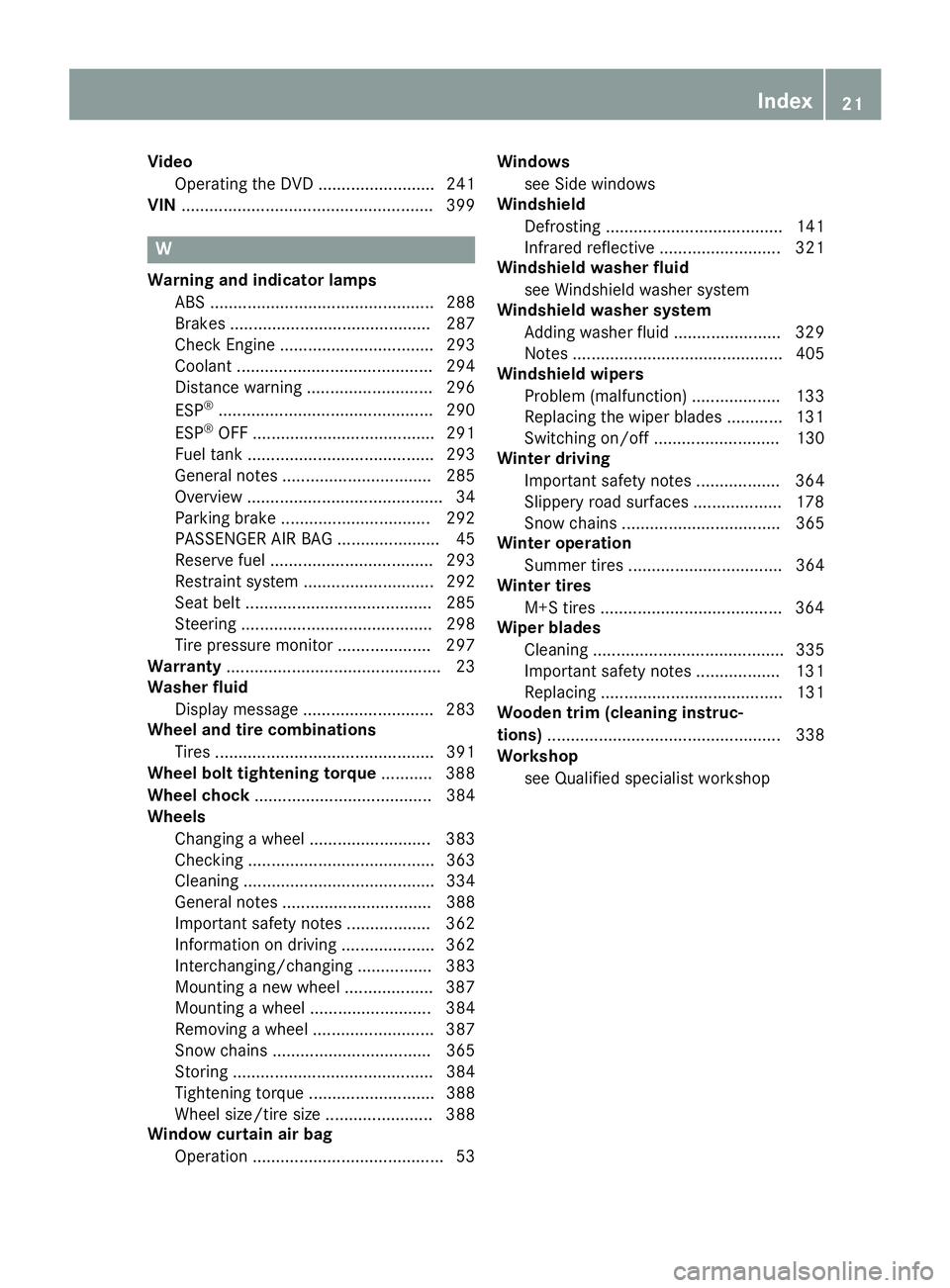
VideoOperating the DVD ......................... 241
VIN ...................................................... 399
W
Warning and indicator lamps
ABS ................................................ 288
Brakes ........................................... 287
Check Engine ................................. 293
Coolant .......................................... 294
Distance warning ........................... 296
ESP
®.............................................. 290
ESP®OFF ....................................... 291
Fuel tank ........................................ 293
General notes ................................ 285
Overview .......................................... 34
Parking brake ................................ 292
PASSENGER AIR BAG ...................... 45
Reserve fuel ................................... 293
Restraint system ............................ 292
Seat belt ........................................ 285
Steering ......................................... 298
Tire pressure monitor .................... 297
Warranty .............................................. 23
Washer fluid
Display message ............................ 283
Wheel and tire combinations
Tires ............................................... 391
Wheel bolt tightening torque ........... 388
Wheel chock ...................................... 384
Wheels
Changing a wheel .......................... 383
Checking ........................................ 363
Cleaning ......................................... 334
General notes ................................ 388
Important safety notes .................. 362
Information on driving .................... 362
Interchanging/changing ................ 383
Mounting a new wheel ................... 387
Mounting a wheel .......................... 384
Removing a wheel .......................... 387
Snow chains .................................. 365
Storing ........................................... 384
Tightening torque ........................... 388
Wheel size/tire size ....................... 388
Window curtain air bag
Operation ......................................... 53 Windows
see Side windows
Windshield
Defrosting ...................................... 141
Infrared reflective .......................... 321
Windshield washer fluid
see Windshield washer system
Windshield washer system
Adding washer fluid ....................... 329
Notes ............................................. 405
Windshield wipers
Problem (malfunction) ................... 133
Replacing the wiper blades ............ 131
Switching on/off ........................... 130
Winter driving
Important safety notes .................. 364
Slippery road surfaces ................... 178
Snow chains .................................. 365
Winter operation
Summer tires ................................. 364
Winter tires
M+S tires ....................................... 364
Wi
per blades
Cleaning ......................................... 335
Important safety notes .................. 131
Replacing ....................................... 131
Wooden trim (cleaning instruc-
tions) .................................................. 338
Workshop
see Qualified specialist workshop
Index21
Page 75 of 410
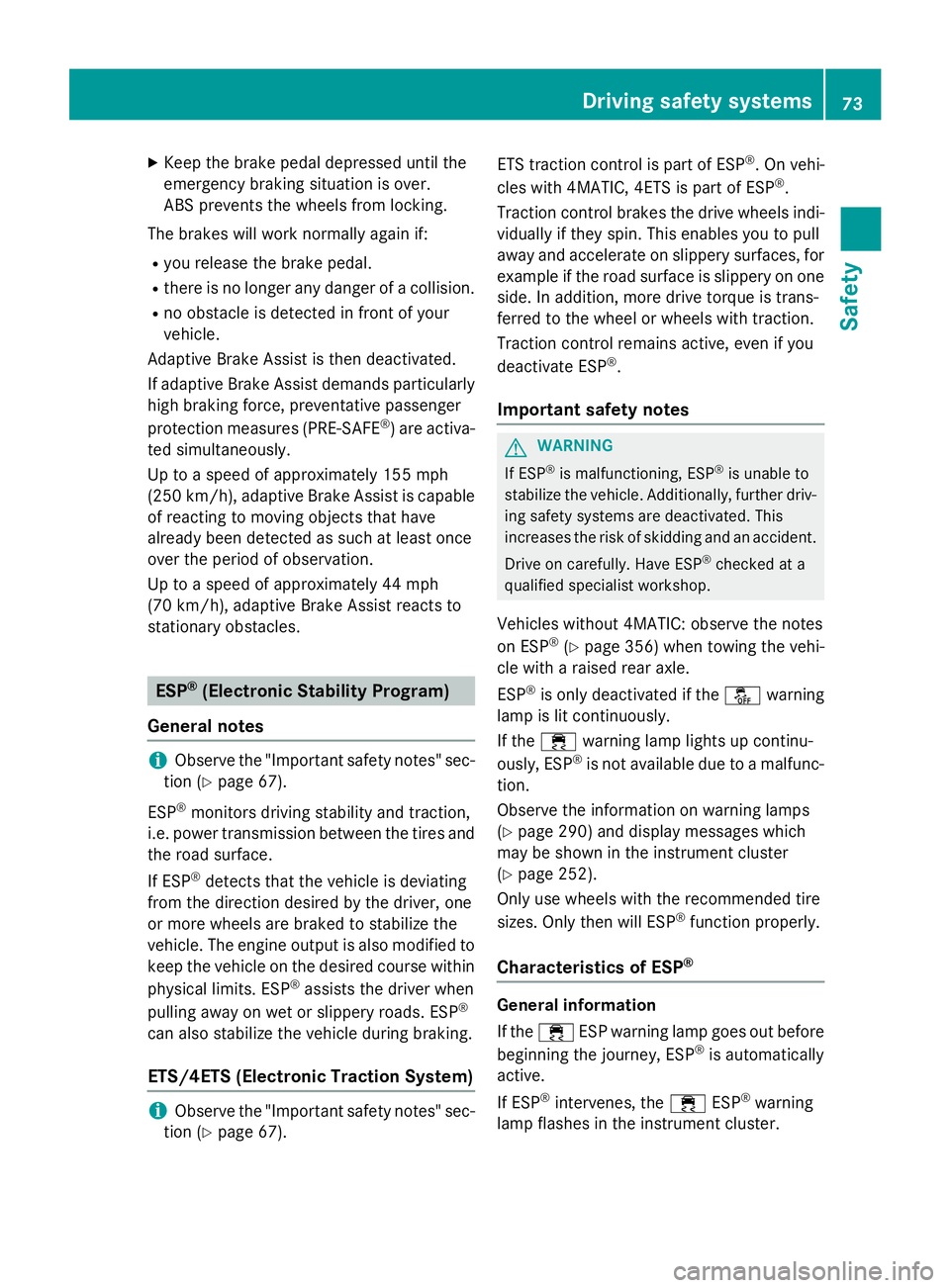
XKeep the brake pedal depressed until the
emergency braking situation is over.
ABS prevents the wheels from locking.
The brakes will work normally again if:
Ryou release the brake pedal.
Rthere is no longer any danger of a collision.
Rno obstacle is detected in front of your
vehicle.
Adaptive Brake Assist is then deactivated.
If adaptive Brake Assist demands particularly
high braking force, preventative passenger
protection measures (PRE-SAFE
®) are activa-
ted simultaneously.
Up to a speed of approximately 155 mph
(250 km/h), adaptive Brake Assist is capable
of reacting to moving objects that have
already been detected as such at least once
over the period of observation.
Up to a speed of approximately 44 mph
(70 km/h), adaptive Brake Assist reacts to
stationary obstacles.
ESP®(Electronic Stability Program)
General notes
iObserve the "Important safety notes" sec-
tion (
Ypage 67).
ESP
®monitors driving stability and traction,
i.e. power transmission between the tires and
the road surface.
If ESP
®detects that the vehicle is deviating
from the direction desired by the driver, one
or more wheels are braked to stabilize the
vehicle. The engine output is also modified to
keep the vehicle on the desired course within
physical limits. ESP
®assists the driver when
pulling away on wet or slippery roads. ESP®
can also stabilize the vehicle during braking.
ETS/4ETS (Electronic Traction System)
iObserve the "Important safety notes" sec-
tion (
Ypage 67). ETS traction control is part of ESP
®. On vehi-
cles with 4MATIC, 4ETS is part of ESP®.
Traction control brakes the drive wheels indi-
vidually if they spin. This enables you to pull
away and accelerate on slippery surfaces, for
example if the road surface is slippery on one
side. In addition, more drive torque is trans-
ferred to the wheel or wheels with traction.
Traction control remains active, even if you
deactivate ESP
®.
Important safety notes
GWARNING
If ESP
®is malfunctioning, ESP®is unable to
stabilize the vehicle. Additionally, further driv-
ing safety systems are deactivated. This
increases the risk of skidding and an accident.
Drive on carefully. Have ESP
®checked at a
qualified specialist workshop.
Vehicles without 4MATIC: observe the notes
on ESP®(Ypage 356) when towing the vehi-
cle with a raised rear axle.
ESP
®is only deactivated if the åwarning
lamp is lit continuously.
If the ÷ warning lamp lights up continu-
ously, ESP
®is not available due to a malfunc-
tion.
Observe the information on warning lamps
(
Ypage 290) and display messages which
may be shown in the instrument cluster
(
Ypage 252).
Only use wheels with the recommended tire
sizes. Only then will ESP
®function properly.
Characteristics of ESP®
General information
If the ÷ ESP warning lamp goes out before
beginning the journey, ESP
®is automatically
active.
If ESP
®intervenes, the ÷ESP®warning
lamp flashes in the instrument cluster.
Driving safety systems73
Safety
Z
Page 221 of 410
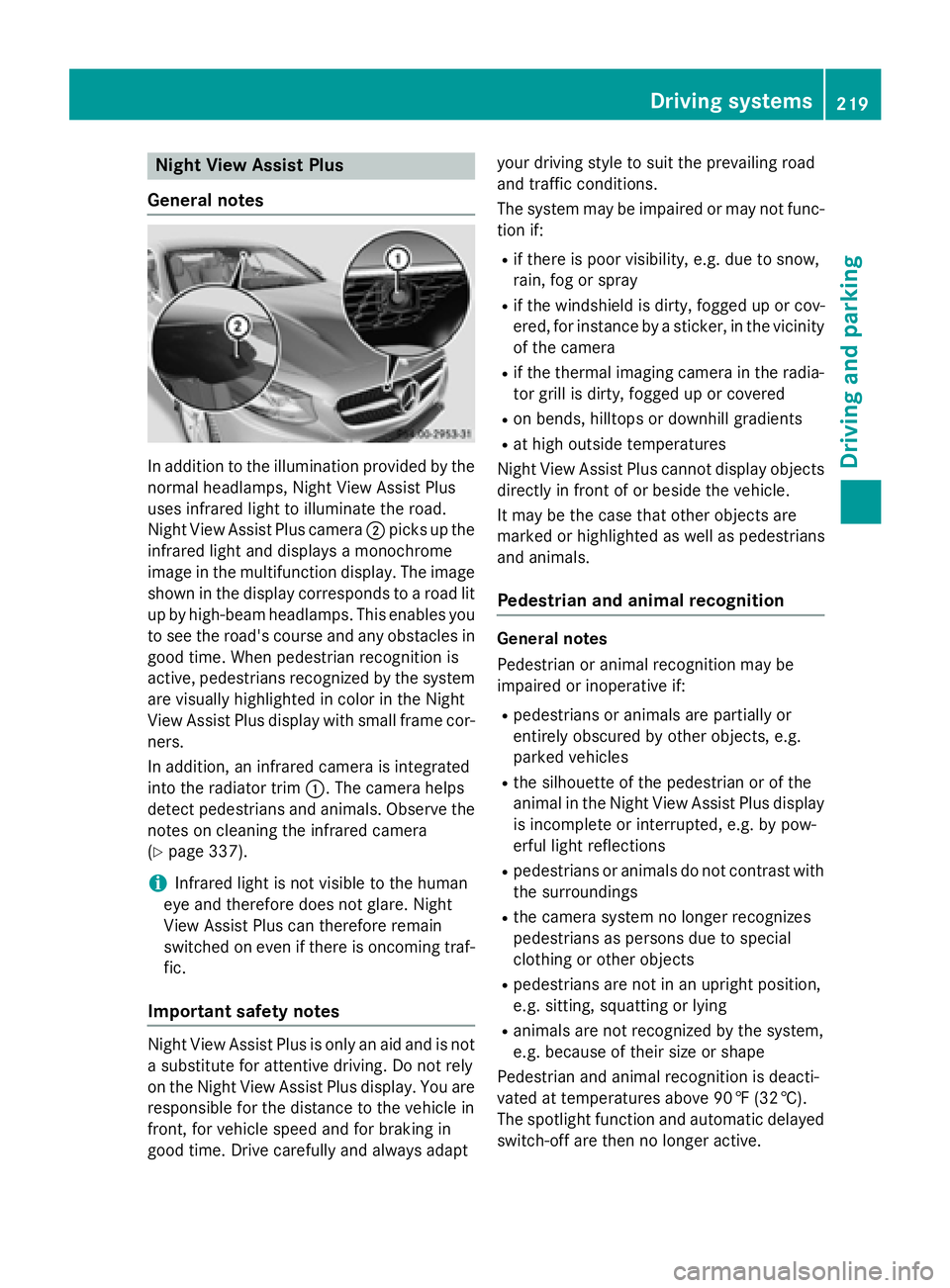
Night View Assist Plus
General notes
In addition to the illumination provided by the
normal headlamps, Night View Assist Plus
uses infrared light to illuminate the road.
Night View Assist Plus camera ;picks up the
infrared light and displays a monochrome
image in the multifunction display. The image
shown in the display corresponds to a road lit
up by high-beam headlamps. This enables you to see the road's course and any obstacles in
good time. When pedestrian recognition is
active, pedestrians recognized by the system are visually highlighted in color in the Night
View Assist Plus display with small frame cor-
ners.
In addition, an infrared camera is integrated
into the radiator trim :. The camera helps
detect pedestrians and animals. Observe the
notes on cleaning the infrared camera
(
Ypage 337).
iInfrared light is not visible to the human
eye and therefore does not glare. Night
View Assist Plus can therefore remain
switched on even if there is oncoming traf-
fic.
Important safety notes
Night View Assist Plus is only an aid and is not
a substitute for attentive driving. Do not rely
on the Night View Assist Plus display. You are
responsible for the distance to the vehicle in
front, for vehicle speed and for braking in
good time. Drive carefully and always adapt your driving style to suit the prevailing road
and traffic conditions.
The system may be impaired or may not func-
tion if:
Rif there is poor visibility, e.g. due to snow,
rain, fog or spray
Rif the windshield is dirty, fogged up or cov-
ered, for instance by a sticker, in the vicinity
of the camera
Rif the thermal imaging camera in the radia-
tor grill is dirty, fogged up or covered
Ron bends, hilltops or downhill gradients
Rat high outside temperatures
Night View Assist Plus cannot display objects
directly in front of or beside the vehicle.
It may be the case that other objects are
marked or highlighted as well as pedestrians
and animals.
Pedestrian and animal recognition
General notes
Pedestrian or animal recognition may be
impaired or inoperative if:
Rpedestrians or animals are partially or
entirely obscured by other objects, e.g.
parked vehicles
Rthe silhouette of the pedestrian or of the
animal in the Night View Assist Plus display
is incomplete or interrupted, e.g. by pow-
erful light reflections
Rpedestrians or animals do not contrast with
the surroundings
Rthe camera system no longer recognizes
pedestrians as persons due to special
clothing or other objects
Rpedestrians are not in an upright position,
e.g. sitting, squatting or lying
Ranimals are not recognized by the system,
e.g. because of their size or shape
Pedestrian and animal recognition is deacti-
vated at temperatures above 90 ‡ (32 †).
The spotlight function and automatic delayed
switch-off are then no longer active.
Driving system s219
Driving an d parking
Z
Page 345 of 410
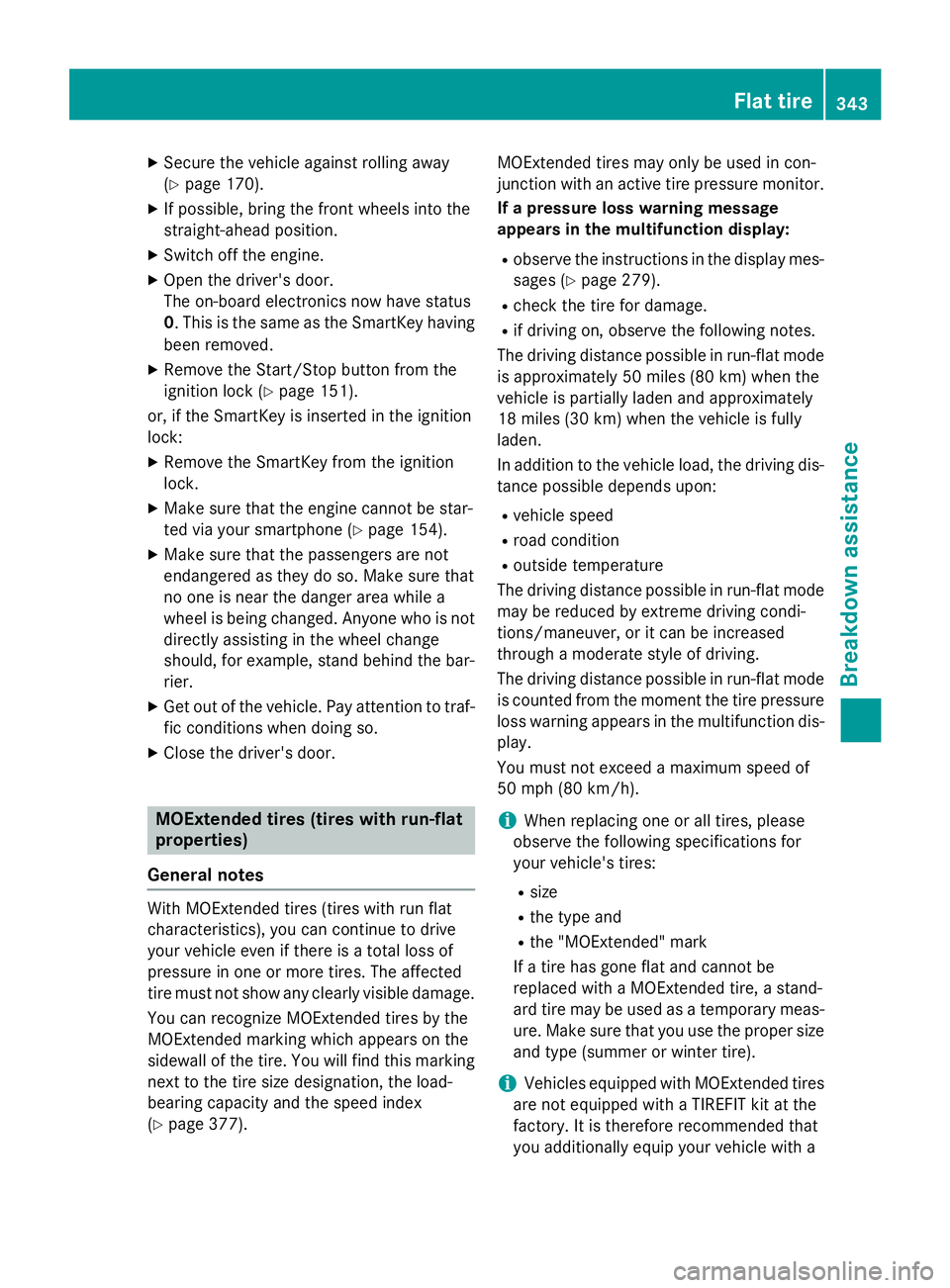
XSecure the vehicle against rolling away
(
Ypage 170).
XIf possible, bring the front wheels into the
straight-ahead position.
XSwitch off the engine.
XOpen the driver's door.
The on-board electronics now have status
0. This is the same as the SmartKey having
been removed.
XRemove the Start/Stop button from the
ignition lock (
Ypage 151).
or, if the SmartKey is inserted in the ignition
lock:
XRemove the SmartKey from the ignition
lock.
XMake sure that the engine cannot be star-
ted via your smartphone (
Ypage 154).
XMake sure that the passengers are not
endangered as they do so. Make sure that
no one is near the danger area while a
wheel is being changed. Anyone who is not directly assisting in the wheel change
should, for example, stand behind the bar-
rier.
XGet out of the vehicle. Pay attention to traf-
fic conditions when doing so.
XClose the driver's door.
MOExtended tires (tires with run-flat
properties)
General notes
With MOExtended tires (tires with run flat
characteristics), you can continue to drive
your vehicle even if there is a total loss of
pressure in one or more tires. The affected
tire must not show any clearly visible damage.
You can recognize MOExtended tires by the
MOExtended marking which appears on the
sidewall of the tire. You will find this marking next to the tire size designation, the load-
bearing capacity and the speed index
(
Ypage 377). MOExtended tires may only be used in con-
junction with an active tire pressure monitor.
If a pressure loss warning message
appears in the multifunction display:
Robserve the instructions in the display mes-
sages (
Ypage 279).
Rcheck the tire for damage.
Rif driving on, observe the following notes.
The driving distance possible in run-flat mode
is approximately 50 miles (80 km) when the
vehicle is partially laden and approximately
18 miles (30 km) when the vehicle is fully
laden.
In addition to the vehicle load, the driving dis-
tance possible depends upon:
Rvehicle speed
Rroad condition
Routside temperature
The driving distance possible in run-flat mode
may be reduced by extreme driving condi-
tions/maneuver, or it can be increased
through a moderate style of driving.
The driving distance possible in run-flat mode
i
s counted from the moment the tire pressure
loss warning appears in the multifunction dis-
play.
You must not exceed a maximum speed of
50 mph (80 km/h).
iWhen replacing one or all tires, please
observe the following specifications for
your vehicle's tires:
Rsize
Rthe type and
Rthe "MOExtended" mark
If a tire has gone flat and cannot be
replaced with a MOExtended tire, a stand-
ard tire may be used as a temporary meas-
ure. Make sure that you use the proper size
and type (summer or winter tire).
iVehicles equipped with MOExtended tires
are not equipped with a TIREFIT kit at the
factory. It is therefore recommended that
you additionally equip your vehicle with a
Flat tire343
Breakdown assistance
Page 364 of 410
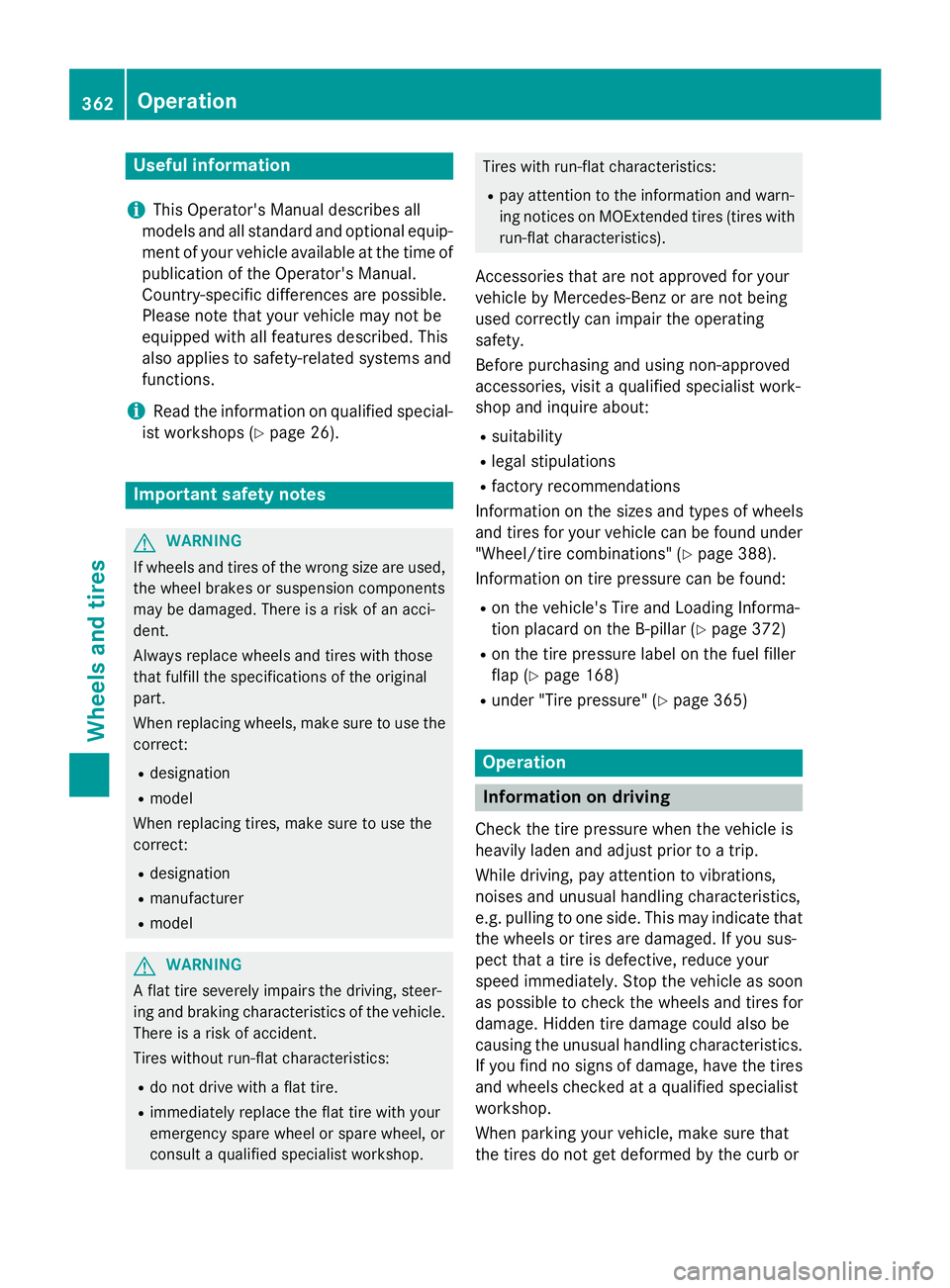
Useful information
i
This Operator's Manual describes all
models and all standard and optional equip-
ment of your vehicle available at the time of
publication of the Operator's Manual.
Country-specific differences are possible.
Please note that your vehicle may not be
equipped with all features described. This
also applies to safety-related systems and
functions.
iRead the information on qualified special-
ist workshops (
Ypage 26).
Important safety notes
GWARNING
If wheels and tires of the wrong size are used, the wheel brakes or suspension components
may be damaged. There is a risk of an acci-
dent.
Always replace wheels and tires with those
that fulfill the specifications of the original
part.
When replacing wheels, make sure to use the
correct:
Rdesignation
Rmodel
When replacing tires, make sure to use the
correct:
Rdesignation
Rmanufacturer
Rmodel
GWARNING
A flat tire severely impairs the driving, steer-
ing and braking characteristics of the vehicle.
There is a risk of accident.
Tires without run-flat characteristics:
Rdo not drive with a flat tire.
Rimmediately replace the flat tire with your
emergency spare wheel or spare wheel, or
consult a qualified specialist workshop.
Tires with run-flat characteristics:
Rpay attention to the information and warn-
ing notices on MOExtended tires (tires with
run-flat characteristics).
Accessories that are not approved for your
vehicle by Mercedes-Benz or are not being
used correctly can impair the operating
safety.
Before purchasing and using non-approved
accessories, visit a qualified specialist work-
shop and inquire about:
Rsuitability
Rlegal stipulations
Rfactory recommendations
Information on the sizes and types of wheels
and tires for your vehicle can be found under "Wheel/tire combinations" (
Ypage 388).
Information on tire pressure can be found:
Ron the vehicle's Tire and Loading Informa-
tion placard on the B-pillar (
Ypage 372)
Ron the tire pressure label on the fuel filler
flap (
Ypage 168)
Runder "Tire pressure" (Ypage 365)
Operation
Information on driving
Check the tire pressure when the vehicle is
heavily laden and adjust prior to a trip.
While driving, pay attention to vibrations,
noises and unusual handling characteristics,
e.g. pulling to one side. This may indicate that
the wheels or tires are damaged. If you sus-
pect that a tire is defective, reduce your
speed immediately. Stop the vehicle as soon
as possible to check the wheels and tires for
damage. Hidden tire damage could also be
causing the unusual handling characteristics.
If you find no signs of damage, have the tires and wheels checked at a qualified specialist
workshop.
When parking your vehicle, make sure that
the tires do not get deformed by the curb or
362Operation
Wheels and tires
Page 366 of 410
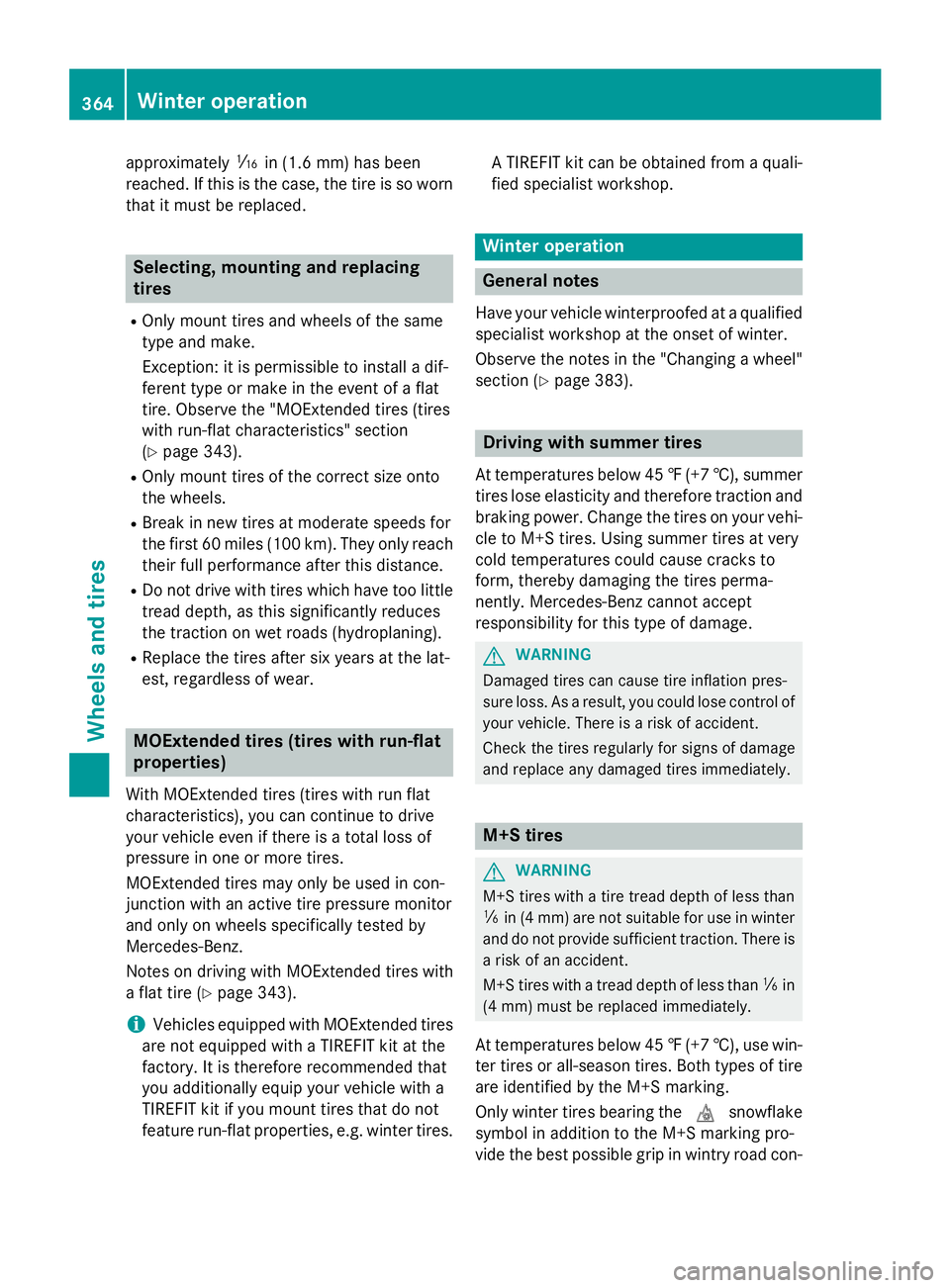
approximatelyáin(1.6 mm )ha sbeen
re ached. If this is the case, the tire is so worn
that it must be replaced.
Selecting, mounting and replacing
tires
ROnly mount tires and wheels of the same
type and make.
Exception: it is permissible to install a dif-
ferent type or make in the event of a flat
tire. Observe the "MOExtended tires (tires
with run-flat characteristics" section
(
Ypage 343).
ROnly mount tires of the correct size onto
the wheels.
RBreak in new tires at moderate speeds for
the first 60 miles (100 km). They only reach
their full performance after this distance.
RDo not drive with tires which have too little
tread depth, as this significantly reduces
the traction on wet roads (hydroplaning).
RReplace the tires after six years at the lat-
est, regardless of wear.
MOExtended tires (tires with run-flat
properties)
With MOExtended tires (tires with run flat
characteristics), you can continue to drive
your vehicle even if there is a total loss of
pressure in one or more tires.
MOExtended tires may only be used in con-
junction with an active tire pressure monitor
and only on wheels specifically tested by
Mercedes-Benz.
Notes on driving with MOExtended tires with
a flat tire (
Ypage 343).
iVehicles equipped with MOExtended tires
are not equipped with a TIREFIT kit at the
factory. It is therefore recommended that
you additionally equip your vehicle with a
TIREFIT kit if you mount tires that do not
feature run-flat properties, e.g. winter tires. A TIREFIT kit can be obtained from a quali-
fied specialist workshop.
Winter operation
General notes
Have your vehicle winterproofed at a qualified
specialist workshop at the onset of winter.
Observe the notes in the "Changing a wheel"
section (
Ypage 383).
Driving with summer tires
At temperatures below 45
‡(+7 †), summer
tires lose elasticity and therefore traction and
braking power. Change the tires on your vehi-
cle to M+S tires. Using summer tires at very
cold temperatures could cause cracks to
form, thereby damaging the tires perma-
nently. Mercedes-Benz cannot accept
responsibility for this type of damage.
GWARNING
Damaged tires can cause tire inflation pres-
sure loss. As a result, you could lose control of
your vehicle. There is a risk of accident.
Check the tires regularly for signs of damage
and replace any damaged tires immediately.
M+S tires
GWARNING
M+S tires with a tire tread depth of less than
ã in (4 mm) are not suitable for use in winter
and do not provide sufficient traction. There is
a risk of an accident.
M+S tires with a tread depth of less than ãin
(4 mm) must be replaced immediately.
At temperatures below 45 ‡(+7 †), use win-
ter tires or all-season tires. Both types of tire
are identified by the M+S marking.
Only winter tires bearing the isnowflake
symbol in addition to the M+S marking pro-
vide the best possible grip in wintry road con-
364Winter operation
Wheels and tires
Page 368 of 410
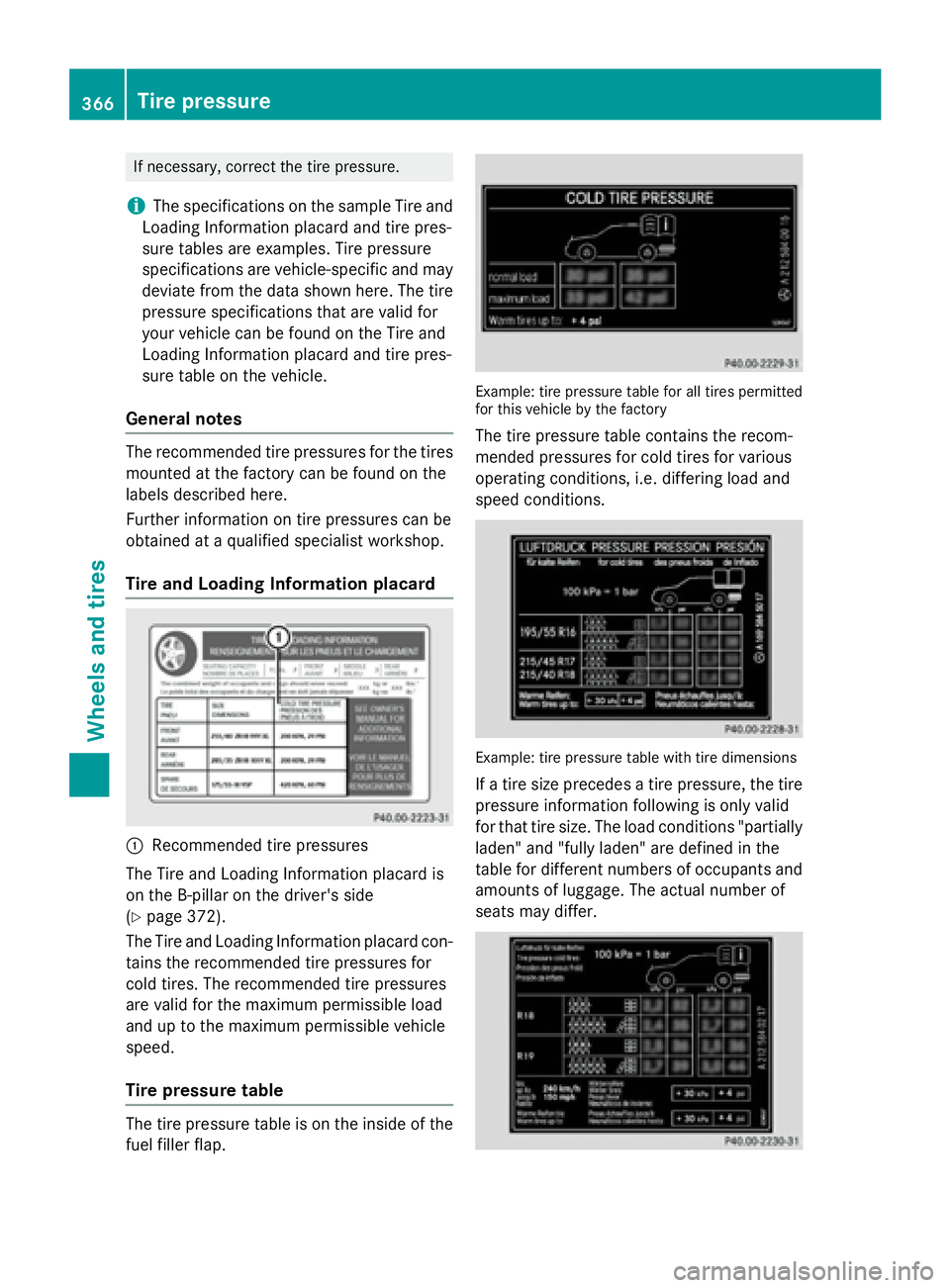
If necessary, correct the tire pressure.
iThe specifications on the sample Tire and
Loading Information placard and tire pres-
sure tables are examples. Tire pressure
specifications are vehicle-specific and may
deviate from the data shown here. The tire
pressure specifications that are valid for
your vehicle can be found on the Tire and
Loading Information placard and tire pres-
sure table on the vehicle.
General notes
The recommended tire pressures for the tires
mounted at the factory can be found on the
labels described here.
Further information on tire pressures can be
obtained at a qualified specialist workshop.
Tire and Loading Information placard
:Recommended tire pressures
The Tire and Loading Information placard is
on the B-pillar on the driver's side
(
Ypage 372).
The Tire and Loading Information placard con-
tains the recommended tire pressures for
cold tires. The recommended tire pressures
are valid for the maximum permissible load
and up to the maximum permissible vehicle
speed.
Tire pressure table
The tire pressure table is on the inside of the
fuel filler flap.
Example: tire pressure table for all tires permitted
for this vehicle by the factory
The tire pressure table contains the recom-
mended pressures for cold tires for various
operating conditions, i.e. differing load and
speed conditions.
Example: tire pressure table with tire dimensions
If a tire size precedes a tire pressure, the tire
pressure information following is only valid
for that tire size. The load conditions "partially
laden" and "fully laden" are defined in the
table for different numbers of occupants and
amounts of luggage. The actual number of
seats may differ.
366Tire pressure
Wheels and tires